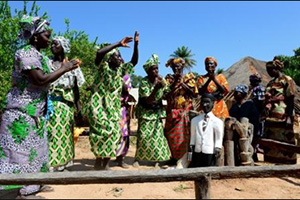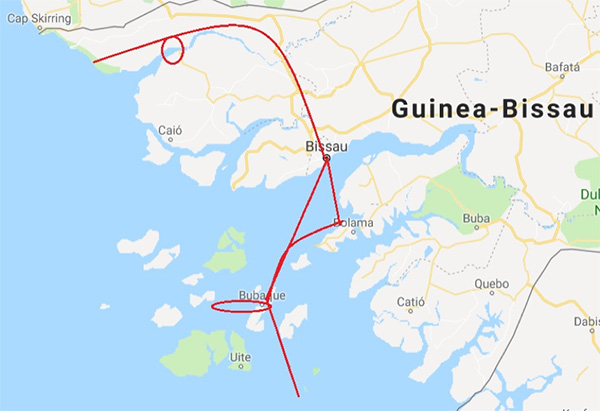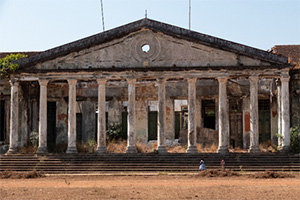Tour to Guinea Bissau & Bijagos: The Sacred Archipelago

Duration: 9 days
Area: Guinea Bissau, Bijagos
Style: cultural tour
Comfort Level:![]()
![]()
![]()
![]()
![]()
GUINEA BISSAU & BIJAGOS:
THE SACRED ARCHIPELAGO
(Discovery)
9 DAYS / 8 NIGHTS
Scheduled departure dates from Bissau in 2020:
Oct 29th (Turtle nesting)
December 27th (Turtle nesting, high season rate)
Minimum 2 – Maximum 16 participants
Any other date upon request
Guinea Bissau, a still unknown country where borders between water and land change with the changing of the tides, covering and uncovering mangroves, beaches and estuaries. A trip that will take us to pristine forests, remote villages, animistic ceremonies and the largest archipelago in Africa: the Bijagos. Most of the Bijagos islands have no permanent settlements and are a real paradise for many bird species and rare fauna. Finally, Bissau gives a great opportunity to experience the intriguing mix of Portuguese and African style, spreading unique vibes.
An itinerary aiming at discovering nature and culture as well as some relax to enjoy the blue ocean and wild beaches where our footprints are the only tracks.
For travelers who look for something new and very special in Africa!

What is Special about the trip
Following the “uncertain border” between land and water, we move across natural environments such as deserts, mangrove swamps, forests, ocean and islands. By traveling from north to south we follow the route of migratory birds, a constant presence along the whole journey. Depending on the departure date, we may discover rare endemic fauna.
Turtle Nesting - Poilao Island (G.B.) is an uninhabited site of a great beauty. It is also considered the main nesting ground for the Green Sea Turtle (Chelonia Midas) in West Africa. In the night, on the silent beach, we wait for the magic moment when a female emerges from the ocean and digs a deep hole where she lays her eggs. If luck will be on our side, we will witness this natural wonder of nature and/or the hatching, when the tiny ones emerge from the sand to join the ocean and begin a long journey that will bring them back to this same beach after 30 years, when they reach sexual maturity.

| Day 1 | Arrival in Bissau, the capital of Guinea Bissau and transfer to the hotel. |
| Day 2 | Explore cult for the ancestors |
| Day 3 | Visit villages of the flooded forest |
| Day 4 | Reminiscences of colonial time |
| Day 5 | Bissau the capital |
| Day 6 | From the ghost capital to the Bijagos Archipelago |
| Day 7 | Turtles |
| Day 8 | Beach and relax |
| Day 9 | To Bissau |
Detailed Itinerary
Day 1: Bissau, the capital – GUINEA BISSAU
Arrival in Bissau and transfer to the hotel.
Meals: own arrangements
Overnight: Hotel Azalai or similar (all rooms en-suite and with air conditioning)
Day 2: Cult for the ancestors – GUINEA BISSAU
 Living Bissau, we will visit Bandin the largest market in the country. Full day dedicated to exploring the region inhabited by the Manjaco. This ethnic group calls their traditions “Gendiman” and keeps them still very much alive. We visit tiny villages hidden in the forest to discover sculptured wooden poles called “Pecab” representing the spirits of their ancestors; they are kept in sanctuaries known as “Cab Balugun”. With the permission of the elders, we will have the opportunity to admire sacred wooden sculptures varying in age and styles. It is indeed a unique opportunity to enjoy tribal art in its original cultural context: the village.
Living Bissau, we will visit Bandin the largest market in the country. Full day dedicated to exploring the region inhabited by the Manjaco. This ethnic group calls their traditions “Gendiman” and keeps them still very much alive. We visit tiny villages hidden in the forest to discover sculptured wooden poles called “Pecab” representing the spirits of their ancestors; they are kept in sanctuaries known as “Cab Balugun”. With the permission of the elders, we will have the opportunity to admire sacred wooden sculptures varying in age and styles. It is indeed a unique opportunity to enjoy tribal art in its original cultural context: the village.
Meals: B – L - D
Overnight: Hotel Banagam (all rooms en-suite and with air-conditioned, basic comfort)
Day 3: Villages of the flooded forest – GUINEA BISSAU
By car and by foot we reach some remote villages inhabited by the Felupes and Baiotes, both tribes part of the Diola ethnic group. They live in an isolated ecosystem where, thanks to their complex “tribal technology”, they manage to desalinate the land and farm rice. We will walk in a unique landscape made up of streams, salt swamps, flat lands, clay dams and rice farms. In this remote environment, some huge isolated Kapok and Baobab trees provide the shade to the tiny human settlements. Local people live in adobe huts built in a distinctive African architectural style: clay “buildings” supported by a complex structure of palm tree poles, surrounded by a shady veranda and covered with high wide thatched roofs, with garrets for aeration. The Felupes practice different ceremonies and the initiated groups include a powerful cast of female priestesses; rituals are generally announced by large sacred drums called “Bombolon”.
In the afternoon we will assist to ritual dances of the Diola sacred mask; rarely shown to the foreigners, this mask belongs to a secret society and the identity of the dancers is not revealed, it is said that the mask is animated by the spirits. Drums, dances and a colourful crowd will enliven the tiny village in the shade of larges kapok trees.
Meals: B – L - D
Overnight: Aparthotel Avo Anisa, simple in Varela
Day 4: Reminiscences of colonial time – GUINEA BISSAU
We drive to Quinhamel to visit of a traditional healer specialized in the treatment of bone injures. He will show us the herbals and traditional medicaments and explain us his way of proceeding and how he became a “healer”. Visit of an old-style local rum distillery (Cana) dating back to the old colonial days and walk across a cashew nuts plantation, the main export product of the country.
Meals: B – L - D
Overnight: Cupedo hotel (all rooms en-suite and with air-conditioned, basic comfort) – NO TWINS
Day 5: Bissau the capital – GUINEA BISSAU
Morning spent discovering the magical and animistic traditions of the intriguing Pepel people. In this region the forest hides a fetish endowed with feared powers: only the initiated young men can carry it on their shoulders...
In the afternoon we arrive at Bissau. We will stroll around Bissau-Vehlo: the lively old quarter with its sleepy streets and alleys. Here we will be amazed by the interesting Portuguese architecture which gives Bissau an atmosphere that reminds us of Portugal back in the days. Old wooden café where to drink Portuguese wine and watch Portuguese news. Or an open-air restaurant where to drink the best mojito in town...
Meals: B – L - D
Overnight: Hotel Azalai (all rooms en-suite and with air conditioned)
Day 6: From the ghost capital to the Bijagos Archipelago
 Aboard a speedboat, we start our sailing to discover the Bijagos Archipelago with its remote islands and isolated human settlements. The Bijagos Archipelago is located approximately 40 miles off-shore and, with its 88 islands (of which only 21 are permanently inhabited), is the largest archipelago in Africa. With its wild and pristine landscapes, its genuine tribal culture and its unique fauna, Bijagos is a “geographical jewel”.
Aboard a speedboat, we start our sailing to discover the Bijagos Archipelago with its remote islands and isolated human settlements. The Bijagos Archipelago is located approximately 40 miles off-shore and, with its 88 islands (of which only 21 are permanently inhabited), is the largest archipelago in Africa. With its wild and pristine landscapes, its genuine tribal culture and its unique fauna, Bijagos is a “geographical jewel”.
Due to the remoteness of the destination, the lack of transportation and the deep attachment to the local traditions, the Bijagos inhabitants have been little influenced by the external world: during ceremonies women still wear the saiya - a traditional skirt made of straw - and the rhythm of life in villages is given by initiations and secret ceremonies – for example young men have to go through a seven-year initiation rite during which they live in a “convent” without any contact with women..
Our first stop will be Bolama Island, the former capital of Portuguese Guinea from 1871 to 1941, before it was moved to Bissau. When the Portuguese left, native people came to live in the town which is now falling apart and is partly invaded by tropical vegetation. It was originally built following the plans of a «Castrum Romanum» (roman citadel) so today we can witness its large sunny lethargic avenues, its empty squares, its dry fountains, its bush-like gardens and its charming administrative buildings in neo Palladian style. In the Governor’s Palace we can still admire columns in the classic style … where now goats graze! Bolama, although inhabited, is plunged in the fairy-tale atmosphere of a ghost town.
Arrival on Rubane Island where we will stay at the most beautiful lodge of the Bijagos Archipelago.
Meals: B – L - D
Overnight: Hotel Ponta Anchaca or similar (ocean front comfortable bungalows en-suite with air conditioning, private wild beach, sea water swimming pool, spectacular bar and gastronomic restaurant on stilts).
Day 7: Turtles – The Bijagos Archipelago
We move to reach the southern islands hidden in the remotest part of the archipelago which became the * Marine Park of Poilao and Joao Viera *, a protected area of an absolute purity that stretches over 495 Km².
After dark, we will remain silent on the beach until the magical moment when the turtles emerge from the ocean to dig deep holes in the sand and lay their many eggs. If we are lucky, we will witness this wonder of nature and we might even see the hatching with the tiny turtle coming out of the sand already looking for the ocean to begin a long journey that will end on this same island when sexual maturity is reached, 30 years after: males come back to the same place to mate with the females.
Meals: B – L - D
Overnight: in tents, basic
Day 8: Beach and relax – The Bijagos Archipelago
In the morning departure by speedboat to Bubaque.
Visit of Bubaque, the largest village in the archipelago and the only one connected to the continent by a ferry once a week: unpaved alleys, a tiny colorful market, local bars and traders; quite interesting also the ethnographic museum dedicated to the Bijagos culture.
Then we reach our very comfortable hotel on the beach in Rubane Island.
In the afternoon, time to relax on the beach or to discover the lush vegetation and villages of the island.
Meals: B – L - D
Overnight: Hotel Ponta Anchaca or similar
Day 9: To Bissau – GUINEA BISSAU
Relax on the beach
Arrival by speedboat in Bissau, the actual capital of the country. Here a vehicle will be waiting to take us to the hotel to have the last shower.
In the evening transfer to the airport for the flight out.
Meals: B – L
Day-use: Rooms in day-use till 18.00 (all rooms en-suite and with air conditioning)
Day 1: Hotel Azalai or similar, |
|
Day 2: Hotel Banagam |
|
Day 3: Aparthotel Avo Anisa, simple in Varela |
|
Day 4: Cupedo Hotel, |
|
Day 5: Hotel Azalai or similar, |
|
Day 6: Hotel Ponta Anchaca or similar, |
|
Day 7: Tents, basic |
|
Day 8: Hotel Ponta Anchaca or similar , |




